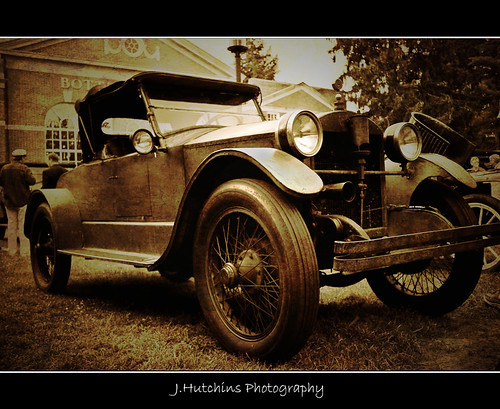Stanley Steamer Car
Image by HuTDoG83
J.Hutchins Photography
Please leave critiques/comments and if you like it, please feel free to favorite it!
Setting
-Saratoga Springs, NY - Steam Car lawn show at the Saratoga Automobile Museum
Shot
-Single Exposure JPG - Nikon D40
Lightroom
-Converted to sephia tone
Photoshop
-Added omni lighting to frontmost tire
-Created a new layer and put a textured layer and set the opacity low on that layer to give the image an "antique photo" look
Early history
1908 Stanley K RaceaboutTwins Francis E. Stanley (1849-1918) and Freelan O. Stanley (1849-1940) founded the company after selling their photographic dry plate business to Eastman Kodak. They produced their first car in 1897. During 1898 and 1899, they produced and sold over 200 cars, more than any other U.S. maker.[2] They later sold the rights to this early design to Locomobile, and in 1902 they formed the Stanley Motor Carriage Company.
Specifications and design
Early Stanley cars had light wooden bodies mounted on tubular steel frames by means of full-elliptic springs. Steam was generated in a vertical fire-tube boiler, mounted beneath the seat, with a vaporizing gasoline (later, kerosene) burner underneath. The boiler was reinforced by winding several layers of piano wire around it, which gave it a strong, yet relatively light-weight, shell. In early models, the vertical fire-tubes were made of copper, and were expanded into holes in the upper and lower crown sheets. In later models, the installation of a condenser caused oil-fouling of the expansion joints, and welded steel fire-tubes were used instead. The boilers were safer than one might expect – they were fitted with safety valves, and even if these failed, a dangerous overpressure would rupture one of the many joints long before the boiler shell was in danger of bursting, and the resulting leak would relieve the boiler pressure and douse the burner with little risk to the occupants of the car. There has never been a documented case of a Stanley boiler exploding in use.[1][2]
The engine had two double-acting cylinders side-by-side, equipped with slide-valves, and was of the simple-expansion type. Drive was transmitted directly from the engine crankshaft to a rear-mounted differential by means of a chain. Locomobiles were often modified by their owners, who added third-party accessories, e.g., improved lubricators, condensers, and devices which mitigated the laborious starting procedure, and so forth.
Later, the Stanley brothers, to overcome patent difficulties with the design they had sold to Locomobile, developed a new automobile model with twin cylinder engines geared directly to the back axle. Later models had aluminium coachwork, but retained many antiquated features, for example the unsprung tubular steel frame.
When they later shifted the steam boiler to the front of the vehicle, the resulting feature was called by owners the "coffin nose." In order to improve range, condensers were used, beginning in 1915. A Stanley Steamer set the world record for the fastest mile in an automobile (28.2 seconds) in 1906. This record was not broken by any automobile until 1911, although Glen Curtiss beat the record in 1907 with a V-8 powered motorcycle at 136 mph (218 km/h). Production rose to 500 cars in 1917.
Obsolescence
During the mid to late 1910s, the fuel efficiency and power delivery of internal combustion engines improved dramatically and the usage of an electric starter rather than a crank, which was notorious for injury to its operators, led to the rise of the gas-powered automobile (which eventually was much cheaper). The Stanley company produced a series of advertising campaigns trying to woo the car-buying public away from the "internal explosion engine," to little effect. An advertising slogan for these campaigns was, "Power - Correctly Generated, Correctly Controlled, Correctly Applied to the Rear Axle." These campaigns are early examples of a fear, uncertainty and doubt type advertising campaign, as their purpose was not so much to convince the audience of the benefits of the Stanley Steamer car as to plant the notion an internal combustion automobile could explode.
Sale and closure
In 1917, the brothers sold their interests to Prescott Warren. The company then endured a period of decline and technological stagnation. As the production specifications show,[3] no models with a power output higher than 20 hp were produced after 1918. Far better cars were available at much lower cost – for example, a 1924 Stanley 740D sedan cost 50, compared to under 0 for a Ford Model T. Widespread use of electric starters in internal combustion cars eroded the greatest remaining technological advantages of the steam car.
Efficiencies of scale, a lack of effective advertising and general public desire for higher speeds and less fussy starting than were possible with the Stanley technology were the primary causes of the company's demise and the factory closed for good in 1924.
Courtesy of Wikipedia.
Car Removal
Image by Travis S.
The car is being lifted so it can be removed.
Later the area was power-washed to get rid of all the foam floating around the streets from pieces that had broken off the bigger blocks.
off the beaten path shows on the odometer
Image by incendiarymind
Just to show how off the beaten path I got during my road trip, the entire trip from Chicago to Washington D.C. according to Yahoo maps is just a few blocks under 700 miles.
I took this photo of my rental car's odometer before I had even reached Philadelphia.
There are much better shots of my trip, of course, but few are more fitting.
And very few are more dangerous. I took this one in stop and go rush hour traffic in the Philadelphia suburbs.
Thankfully, however, I hit 999.9 miles right at a red light.
No comments:
Post a Comment